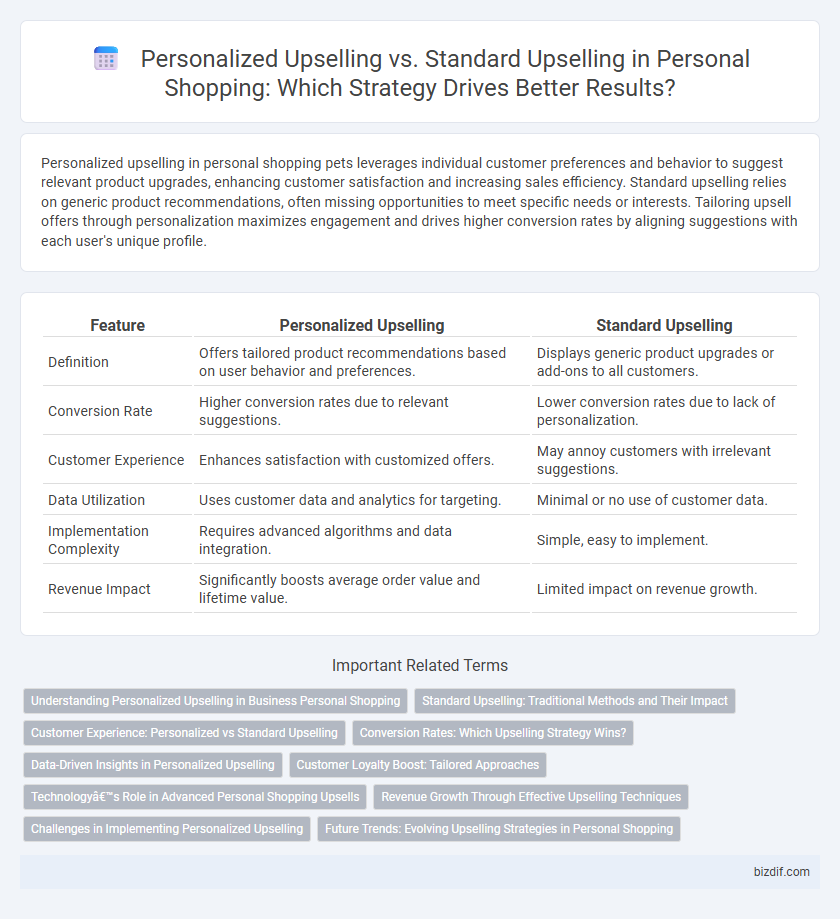Personalized upselling in personal shopping pets leverages individual customer preferences and behavior to suggest relevant product upgrades, enhancing customer satisfaction and increasing sales efficiency. Standard upselling relies on generic product recommendations, often missing opportunities to meet specific needs or interests. Tailoring upsell offers through personalization maximizes engagement and drives higher conversion rates by aligning suggestions with each user's unique profile.
Table of Comparison
| Feature | Personalized Upselling | Standard Upselling |
|---|---|---|
| Definition | Offers tailored product recommendations based on user behavior and preferences. | Displays generic product upgrades or add-ons to all customers. |
| Conversion Rate | Higher conversion rates due to relevant suggestions. | Lower conversion rates due to lack of personalization. |
| Customer Experience | Enhances satisfaction with customized offers. | May annoy customers with irrelevant suggestions. |
| Data Utilization | Uses customer data and analytics for targeting. | Minimal or no use of customer data. |
| Implementation Complexity | Requires advanced algorithms and data integration. | Simple, easy to implement. |
| Revenue Impact | Significantly boosts average order value and lifetime value. | Limited impact on revenue growth. |
Understanding Personalized Upselling in Business Personal Shopping
Personalized upselling in business personal shopping tailors product recommendations based on individual customer preferences, purchase history, and behavior patterns, significantly enhancing the shopping experience. Standard upselling relies on generic offers without customization, often leading to lower engagement and conversion rates. Leveraging data analytics and AI-driven insights enables businesses to implement personalized upselling strategies that increase average order value and customer satisfaction.
Standard Upselling: Traditional Methods and Their Impact
Standard upselling relies on traditional techniques such as suggesting higher-priced items or add-ons during the shopping process, often using scripted pitches or generalized promotions. These methods can lead to increased average order values but may lack relevance to individual customer preferences, potentially reducing overall satisfaction and retention. Despite its widespread use, standard upselling often generates lower conversion rates compared to personalized approaches that leverage customer data and behavior insights.
Customer Experience: Personalized vs Standard Upselling
Personalized upselling enhances customer experience by leveraging individual purchase history and preferences to recommend relevant products, increasing satisfaction and perceived value. Standard upselling relies on generic offers that often miss the mark, leading to lower engagement and potential frustration. Tailored suggestions create a seamless shopping journey, fostering loyalty and higher conversion rates compared to one-size-fits-all tactics.
Conversion Rates: Which Upselling Strategy Wins?
Personalized upselling significantly boosts conversion rates by tailoring product recommendations to individual customer preferences and purchase history, resulting in higher relevance and engagement. Standard upselling relies on generic product suggestions, often leading to lower customer interest and diminished conversion efficiency. Data shows personalized upselling can increase conversion rates by up to 20-30% compared to standard upselling methods.
Data-Driven Insights in Personalized Upselling
Personalized upselling leverages data-driven insights by analyzing individual customer behavior, purchase history, and preferences to recommend relevant products that increase conversion rates and average order value. Unlike standard upselling, which offers generic product suggestions, personalized upselling uses machine learning algorithms and predictive analytics to tailor offers that resonate more deeply with each shopper. This targeted approach enhances customer satisfaction and drives sustained revenue growth through more strategic and effective product recommendations.
Customer Loyalty Boost: Tailored Approaches
Personalized upselling significantly enhances customer loyalty by offering product recommendations based on individual preferences and purchase history, leading to a more engaging shopping experience. Studies show that tailored upselling can increase repeat purchase rates by up to 20% compared to standard upselling techniques, which rely on generic suggestions. Leveraging data-driven insights enables brands to build stronger emotional connections with customers, ultimately boosting long-term retention.
Technology’s Role in Advanced Personal Shopping Upsells
Personalized upselling leverages advanced AI algorithms and customer data analytics to tailor product recommendations based on individual preferences and purchase history, significantly enhancing conversion rates compared to standard upselling techniques. Technologies such as machine learning, predictive modeling, and real-time behavior tracking enable personalized upselling by delivering relevant offers that increase average order value and customer satisfaction. Integrating these technologies into personal shopping platforms creates dynamic, context-aware upsell opportunities that standard upselling methods cannot match.
Revenue Growth Through Effective Upselling Techniques
Personalized upselling leverages customer data and preferences to tailor product recommendations, significantly increasing conversion rates and average order value compared to standard upselling methods. By analyzing purchase history and behavior, personalized upselling creates targeted offers that resonate with individual customers, driving higher customer satisfaction and revenue growth. Studies reveal that businesses implementing personalized upselling techniques experience up to a 20% increase in sales revenue, outperforming generic upselling strategies.
Challenges in Implementing Personalized Upselling
Implementing personalized upselling in personal shopping faces challenges such as data privacy concerns, requiring secure handling of sensitive customer information to build trust. Integration of advanced AI algorithms and machine learning models demands significant investment in technology and expertise. Furthermore, accurately predicting individual customer preferences and behaviors often involves overcoming data silos and ensuring real-time analytics for effective, targeted recommendations.
Future Trends: Evolving Upselling Strategies in Personal Shopping
Personalized upselling leverages AI-driven data analytics and customer behavior insights to offer tailored product recommendations, significantly enhancing conversion rates compared to standard upselling methods that rely on generic promotions. Future trends highlight the integration of AR and machine learning algorithms to create immersive, customized shopping experiences that predict and respond to individual preferences in real-time. As consumer expectations evolve, personal shopping platforms will increasingly adopt dynamic upselling strategies powered by advanced personalization technologies to maximize engagement and revenue growth.
Personalized upselling vs Standard upselling Infographic

 bizdif.com
bizdif.com